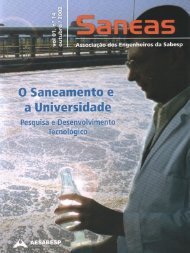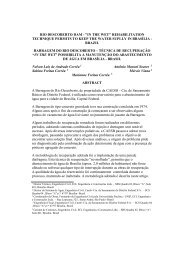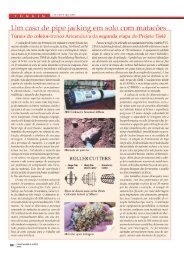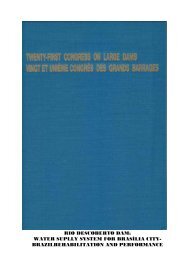USSD Rio Descoberto Dam - Sabino Freitas Correa-ENGL -
22nd US Society of Dams International Meeting Published - Rio Descoberto Dam - Rehabilitation Technique Permits to Keep Water Supply in Brasília - Brazil - Corrêa, Nelson, Corrêa Marianne, Sabino Freitas Correa, Soares,A., Viana,M.
22nd US Society of Dams International Meeting Published - Rio Descoberto Dam - Rehabilitation Technique Permits to Keep Water Supply in Brasília - Brazil - Corrêa, Nelson, Corrêa Marianne, Sabino Freitas Correa, Soares,A., Viana,M.
Create successful ePaper yourself
Turn your PDF publications into a flip-book with our unique Google optimized e-Paper software.
First Evaluations<br />
Before the beginning of the diaphragm wall rehabilitation works, several additional tests,<br />
analyses, and stability calculations were performed. The scope included permeability,<br />
capillarity, compressive and shearing tests at samples of the pilot drive of the diaphragm<br />
drive built in 1993 collected with rotary drilling probe extractors. Shearing tests at<br />
samples extracted from the contact between the diaphragm mortar and the concrete of the<br />
dam were also performed, in order to check the adherence between those different<br />
materials. Additional stability calculations were done addressing the extreme hypothesis of<br />
break of the small dam’s body part between the diaphragm and the upstream face. Those<br />
calculations were done addressing to a CAESB concern about the aggressive soluble<br />
effects of the soft water of the reservoir, with very low solid suspensions, on the upper part<br />
of the dam that would stay in contact with the water. That concern was also dissipated by<br />
the evidence that even staying in contact with the water, that part has the reactive effects<br />
severely decreased after diaphragm insert as a consequence of the end of the reaction<br />
renovation and leaching. Laboratory tests were also conducted with the mortar mixture<br />
indicated by the project designers and performance tests simulating the sub-aquatics mortar<br />
application conditions order to verify the possibility of segregation.<br />
CONSTRUCTION<br />
The rehabilitation construction was performed by two main groups of activities, drilling<br />
teams and mortar underwater application team:<br />
Drilling<br />
The drilling activities were performed with drilling equipments using DTH (down the<br />
hole) hammers, guided by a special alignment template developed for this project. The<br />
drilling machinery had to be adapted specifically for the project in order to have the<br />
drilling equipment tower aligned at the diaphragm axis.<br />
The project included 70,000 meter of 152 mm and 165mm drilled bores in 18 months of<br />
working in two shifts. Midsize drilling equipment were used in the project (with weight<br />
between 6 and 11ton) At the peak of production the job site had five drilling machines<br />
working at the same time, four at the dam crest and one at the spillway top. The deepest<br />
hole reached 38 meter depth, at block “I”, and 22 meter was the average drilling depth of<br />
the project.<br />
Boring deviations caused by flexion were minimized by the use of 100mm masts. Several<br />
types of bits were tested at this project, the concave and drop center types must be<br />
remarked for their best performance and alignment. The guiding template was built<br />
machining heavy hot rolling steel pipe. The drilling sequence, illustrated above at Figure<br />
4.a, consisted of drilling a panel first bore that works as a guide for the next using the<br />
template. Moreover than guidance, the template is necessary avoid bores overlay.






